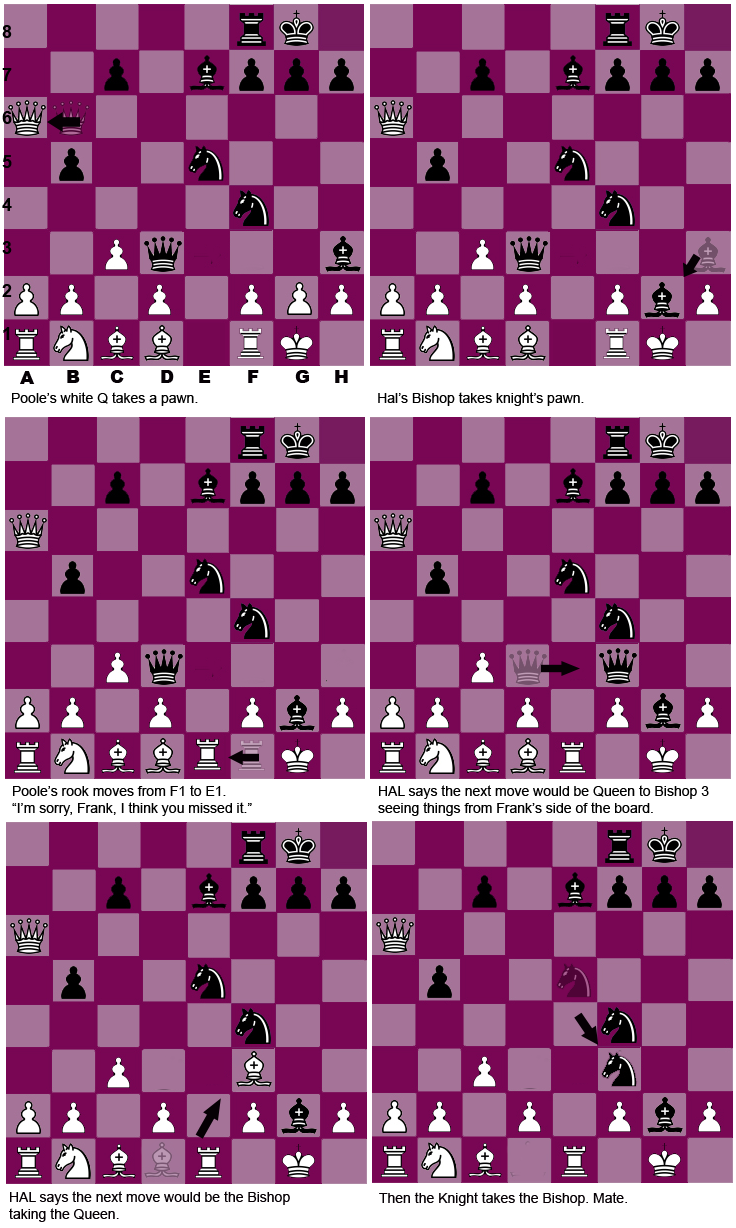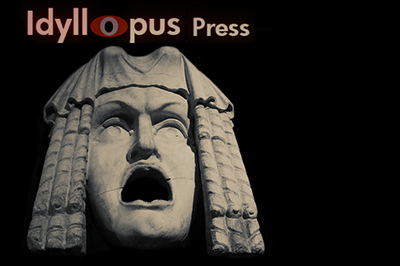The Relationship Between the Chess Game

Go to TOC for this film ( (which has also a statement on purpose and manner of analysis and a disclaimer as to caveat emptor and my knowing anything authoritatively, which I do not, but I do try to not know earnestly, with some discretion, and considerable thought).
We're going to take a look at the chess game between HAL and Frank Poole and then see how it reappears again at the end of the film in Dave's dinner scene in the room beyond the infinite, then connect the dots over to Danny on the reversed rug in The Shining.
In case you don't know chess, first we need to look at notation and how it operates.
Below, from Wikipedia, is algebraic notation. White is always right-side up and black is always upside-down. White is always shown as playing from the bottom and the lower right hand corner is always white or the lighter of the colors.
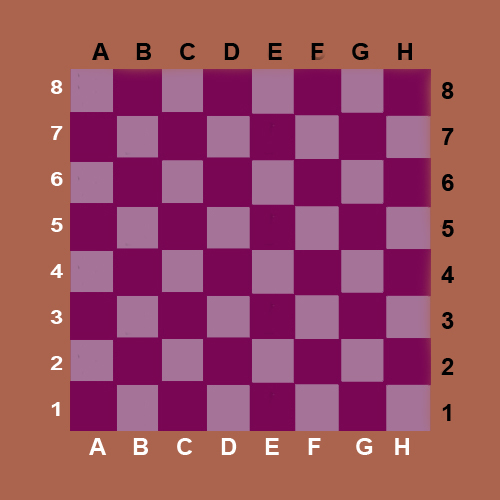
Another system of notation is descriptive notation. The below is from Wikipedia. Though it's said that the white is always right side-up and the black is upside-down, as you can see the columns for black and white are not numbered as in algebraic notation. In algebraic notation, if a white pawn moves from E2 to E4, a corresponding reciprocal move on black's part would be from E7 to E5. In descriptive notation, the white pawn would move from K2 to K4 and the reciprocal corresponding move on the part of the black pawn would be also from K2 to K4. Q is queen and K is king. QR is queen's rook, QN is Queen's knight, QB is Queen's bishop, etc.

Below is the chess board for the game had between HAL and Frank Poole.
In the top left image we have the game as Poole's white queen takes HAL's black pawn.
In the top right image HAL's black bishop takes Poole's knight's pawn.
In the middle left image Poole's rook moves from F1 to E1. Poole describes it as "Rook to King 1" which means he is using descriptive notation here rather than algebraic. It is now that HAL says, "I'm sorry, Frank. I think you missed it."
In the middle right image, HAL says the next move would be "queen to bishop 3". HAL is not expressing the move from his view of the board, he is instead expressing it from Poole's "white" view of the board. HAL should have instead it was moving to bishop 6. HAL then simply says that in the next move (bottom left) the bishop would take the queen, then the knight would take the bishop, mate (bottom right image).
HAL's description of Frank's knight taking his queen infers that is the only move Frank could have made at that point in time. This is not the case and I discuss this in the 3rd section of my analysis.
For the fun of it, there is another entirely different way of looking at HAL's prognostication of the bishop taking the queen and the knight taking the bishop. It's going to look nuts, but here it is, and I'll explain in a moment why I'm doing this..
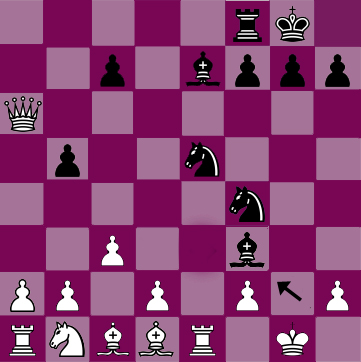
Instead of Poole's white bishop moving from C1 to C2, the black bishop moves from G2 to F3. Then, below, the E5 black knight moves to F3.
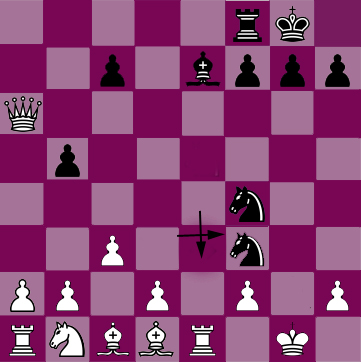
There is no mate. But let's bypass that for a moment. There is even a third way of perceiving HAL's prognostication as we don't have the algebraic notation for the moves and HAL doesn't highlight them.

The third way of perceiving HAL's prognostication is the white bishop moving from D1 to F3 (above) and then the black knight (below) moving from F4 to G2 and taking the black bishop.
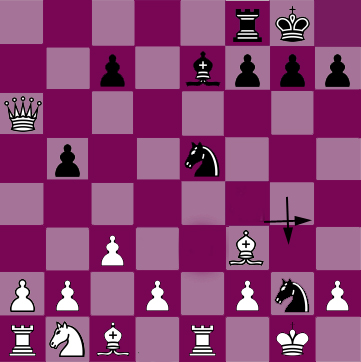
Because neither algebraic nor descriptive notation is used for describing the majority of the moves, I am for now going to present these 3 alternatives based only on the language used, as in my analysis of The Shining I discuss how Kubrick often presents 3 views for a scene, the most notable being the famous bathroom in room 237 where we have Jack's view, Dick's view and Danny's view, and we've no idea really who exactly is seeing what. One reason I feel free to do this here is because HAL has already given the move of the Queen as to bishop 3 when it should have been bishop 6 according to descriptive notation. This plays in with the inversions, the horizontal flips I often talk about our having in Kubrick's films (the first horizontal flip in 2001 being with the appearance of the monolith), which is exactly what it is with bishop 6 becoming instead bishop 3, HAL relating at that point the move on the board from Frank's perspective instead of his own.
People who pay attention to the chess game tend to believe that HAL's speaking of the chess move from Frank's perspective rather than his own is exemplary of an error and that this means he is likely in error when forecasting AE (Alpha Echo) 35's failure. That's not my opinion but I won't get into that here.
It may seem very peculiar, this idea of having three different viewing points/possibilities for the game, and that I am tossing paying any attention to who is playing black and who is playing white, but we already have HAL leading the way with this. For, after all, with doublings and twinnings, and the ideas of these horizontal flip mirrorings, we have dualism and everyone is familiar with black and white's symbolism in dualism, such as expressed in the Yin Yang symbol.
I'll throw in here the opening of this game that was played between HAL and Frank. Wikipedia states the game appears to be based on one played by A. Roesch and W. Schlage in 1910. The opening for that game is below.
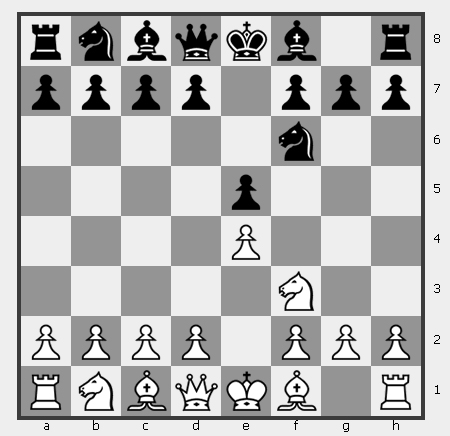
It begins with what is called, in the Encyclopedia of Chess Openings, ECO C44: the King's Pawn Opening.
Below is the ECO A35, English Symmetrical opening.
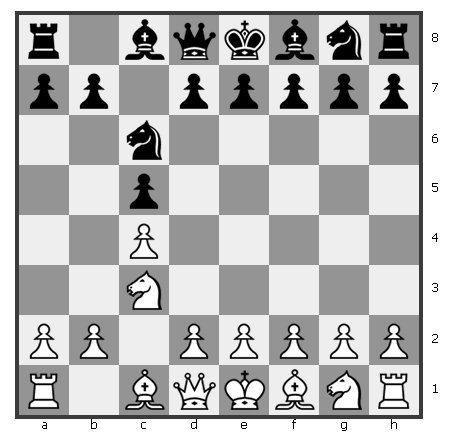
My belief is that the name of the Alpha Echo 35 unit perhaps (of course, maybe not) has an association with the ECO A35 chess opening that displays a symmetry that the ECO C44 doesn't display. However, if we look at black's move of the knight in the C44 opening we can observe that if we were on black's side of the board, the move of the knight is from N1 to B3 just as white's move of the knight is from N1 to B3.
Rather than explore that further right now I'm going to now go to the end of the film.
The first thing I want to do is point out that this room beyond the infnite actually incorporates elements from earlier in the film. Such as if we compare Dave eating at his table, in the room beyond the infinite, to the below shot of Space Station 5 and Earth we will notice a transfer in color scheme and that the table at which Dave dines, with its double wheel, recalls the double wheel of the Space Station. Earth may be said to be represented by the landscape.
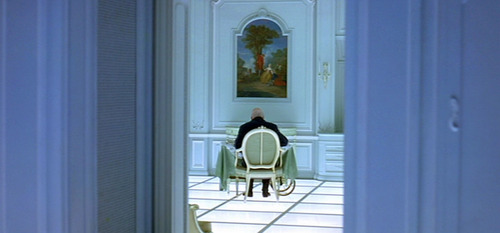
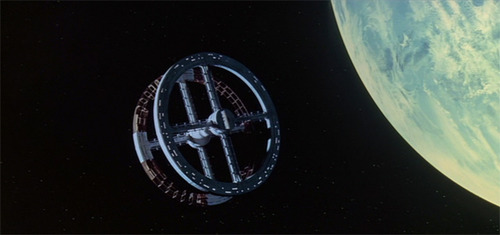
We find also that the illuminated squares of the floor of the room are the same as the illuminated squares of the ceiling in Space Station 5.
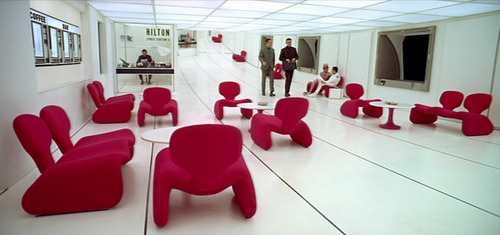
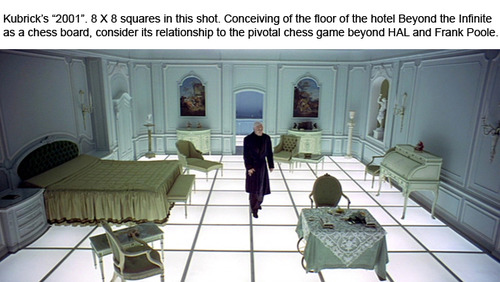
When we first see the room, Kubrick clearly shows that the grid is 10 by 8 squares. Now, however, in shot 584 it is framed so that we have 8 by 8 squares.
The 64 squares of the chess board.
This is the chess board, a return to the game HAL was playing with Frank Poole. The table with its two wheels sits in the same place that Frank's rook was before he moved it. The F1 position or KB1. Rook means chariot. We can see a "chariot" of sorts in the table with its wheels. The table is resting where the "chariot" of the pod was earlier, having taken its place.
Then in shot 585 the table has moved. It is no longer 3 squares over from the wall, at F1 (K1), it is now at E1 (K1). It is instead 4 squares over from the wall. Kubrick has removed the writing desk and left just enough wall to the right showing to let us know the dining table has moved over one square. This is the point in HAL's game with Frank when he says, "I'm sorry, Frank, I think you missed it."
The expanse of white squares beyond Dave gives a sense of the infinite.
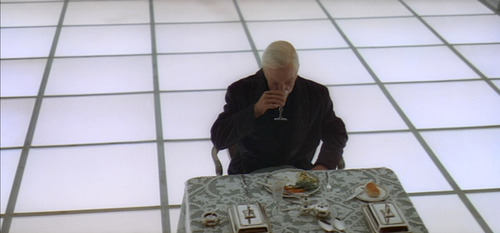
Kubrick does the same thing with the table here as he does with Danny on the "chess board" of the carpet in The Shining. In The Shining Kubrick shows just enough of the wall to the right to reveal that Danny is about 4 "spaces" over from the wall.
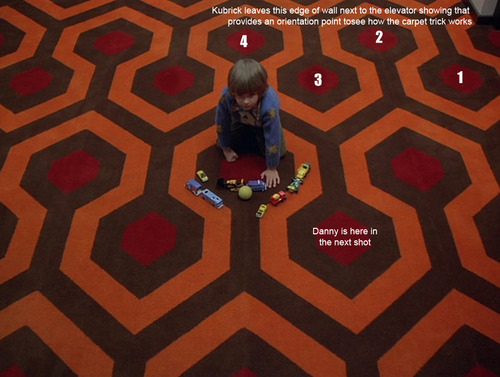
Danny had just reversed some cars on the carpet before the ball rolled toward him and then we had a shift in position that read as a reversal in environment. When we move to the shots following the one above we think of Danny as having been in a "reversed" position, when he is instead now 3 "spaces" out from the wall rather than the 4.
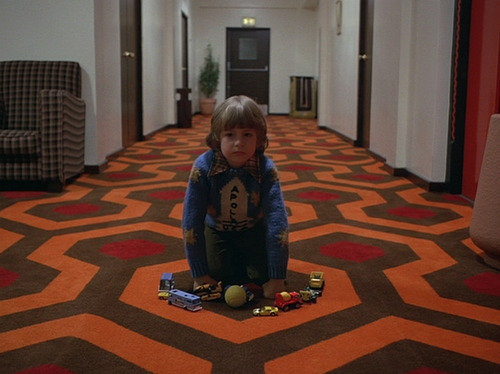
Kubrick, with Bowman, shows just enough to reveal that in shot 585 he is not at F1 but the E1 position. And yet we know from HAL's game with Frank, and Danny's appearance of being on a reserved carpet, that we have both here, the reversal (the moment at which HAL adopts Frank's opposing POV) as well as the initial, personal POV, which is to have both of these point of views present and wedded in one.
So Kubrick does not simply move Danny (in his space-themed Apollo rocket sweater) on the carpet as a means of supplying the reversal effect, he also does this to refer back to the chess game in 2001.

This scene is also hinted at in A Clockwork Orange when Alex dines with Alexander who, in his wheelchair, corresponds to the chariot rook.
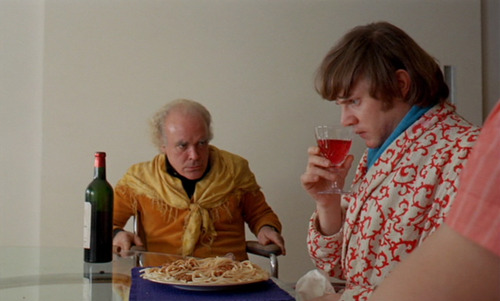
One will recollect that the house's entry has a black and white checkerboard foyer. When Alex is dining Kubrick stages it so that the shots facing the entry of the room appear to be lit with daylight (though we know it's night) while the shots facing the black windows are obviously illuminated by lamps. The lamps are also now illuminated in the glass of the table so that we have Alex situated between the mirroring effect that simulates Danny on the carpet with its intermeshing of mirrored designs.

In 2001, Dave had observed first his elder self at the table from the bathroom. He had then become that elder self even as both become aware of each other. There followed the shift from F1 to E1, Dave sips out of a glass, places it down, then accidentally knocks the glass to the floor where it breaks.
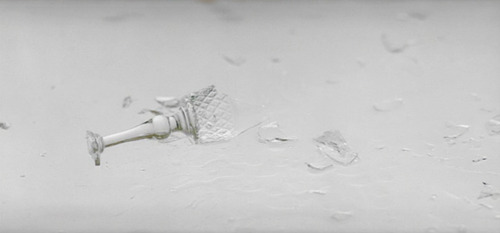
Dave hears his labored breathing on the bed and looks up to see himself on the bed at the point of death/transformation, he becomes this elder self as the monolith appears and he makes an evolutionary leap with his rebirth.
In The Shining, Danny, his attention drawn by the ball that has rolled towards him, looks up to see a door now open to room 237, where he will have his breath choked out of him in the bathroom, will revert to the infantile, and be subsequently replaced for a time by Tony.
Alex, wearing Alexander's robe that he had put on after bathing, is first suspicious of the wine given him, drinks it, but his instincts were right, the wine had been drugged, and he is knocked out. He is already feeling suicidal, unable to see much in the future. He then wakes up to Beethoven's 9th that drives him to a suicidal leap from which he too wakens transformed.
"I came back to life after a long black black gap of what might have been a million years."
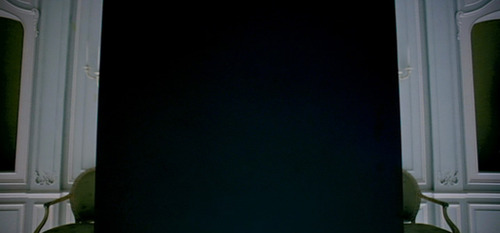
The monolith has everything to do with a point of meeting of opposites. A place "between", where the doubles meet, negative and positive, above and below, the thing and its inverse (though who is to say what is inversed, what is negative and what is positive).
March 2016 extracted from analysis. Approx 2200 words or 5 single-spaced pages. A 17 minute read at 130 wpm.
Return to the top of the page.
Return to Table of Contents for "2001: A Space Odyssey" analysis
Go to Table of Contents for "The Shining" analysis
Go to Table of Contents for "Clockwork Orange" analysis
Link to the main film page for all the analyses

